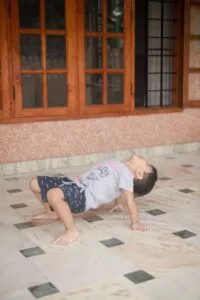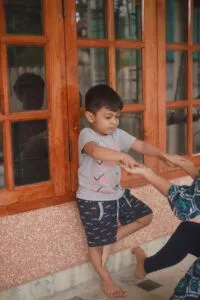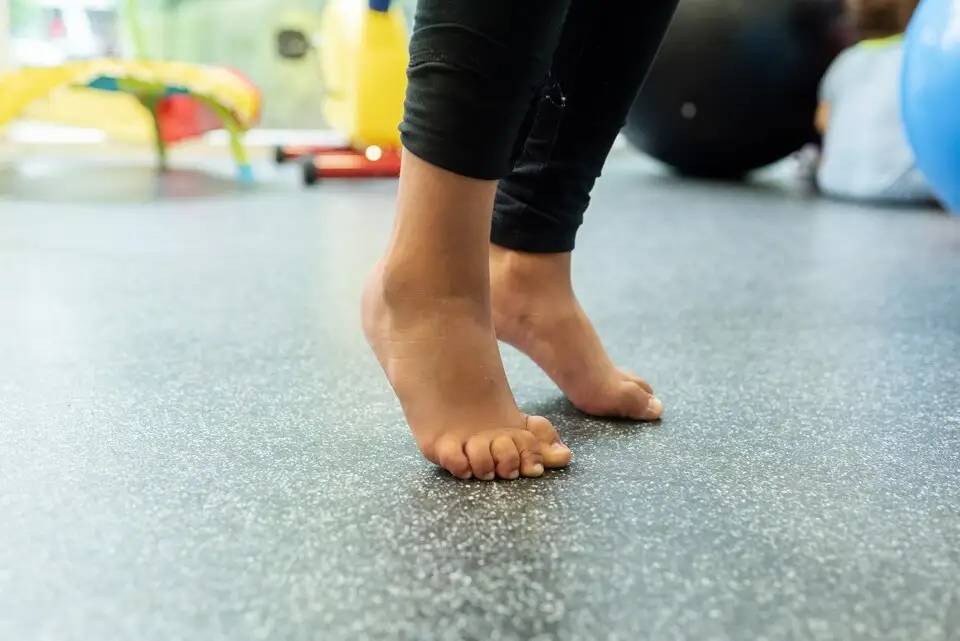
Written by
Angela Grace Varghese, MPT (Paediatrics)
Physiotherapist
Toe walking, AKA equinus gait, needs no special introduction. But correcting it is not as easy as berry picking. It is a condition where the child is on his toes with the heels in the air while walking and doing other weight-bearing activities.
Toe walkers often do not realise that their heels are in the air unless it’s pointed to them. While on the one hand, you stare at the bare reality of recurrence even with the best treatments, on the other hand, you can be comforted that toe walking can disappear on its own the majority of the time. This puts most parents in a mental dilemma whether their child will grow out of the condition!
How can we deal with this condition? What is the best approach? Together, let’s solve the stubborn case of toe walking!
What is Toe Walking?
Toe walking is a condition in which a child walks on the balls of his feet with the heels off the ground for most of the day. When the child continuously walks on his toes over the age of 2, we name it persistent or sometimes idiopathic toe walking. There are two categories of children in whom this will be present:
- Atypical children, and
- Typically growing children
An atypical child is someone who has a strong medical history that could be neurological, congenital or orthopaedic-related. In these children, toe walking is part of their underlying disorder and is usually one of the last things the parent would be concerned about.
On the other hand, atypical child is a normally developing child who has had no signs of concerning medical history. In such kids, toe walking usually starts as an alternate walking pattern which they try out among the many different patterns of walking that kids explore as they start to walk. Usually, it weans off sooner than it started. Unfortunately, in some kids, this does not happen!
What Causes Toe Walking?
There are multiple causes associated with toe walking.
Some of the most common causes of toe walking include:
- Idiopathic cause – no known cause. Such toe walkers are idiopathic toe walkers.
- Tight calf muscles
- Tightness of the achilles tendon
- Congenital orthopaedic conditions like Congenital Talipes EquinoVarus, leg length discrepancies
- Tactile sensory issues – this is very common in conditions like ASD but can also be seen in typically growing children as well.
- Muscular dystrophy: In such children, toe walking is one of the earliest signs suggesting muscular dystrophy.
- Neurological disorders such as Cerebral palsy, Spina bifida
What makes toe walking even more complicated are the risk factors:
- Familial history: Interestingly, a family history of toe walking has been identified in many of the toe walkers.
- Urban living culture: Children who are not exposed to different textures or are not used to walking barefoot may have the chance of developing toe walking due to sensory issues.
- Emotional events: Studies have shown that events that involve extreme stress or extreme excitement can bring back toe-walking behaviour.
- Habitual: You have heard the saying – a habit is hard to break. This is the titbit regarding adult toe walkers. Although the primary causes remain the same, the difference here is that the issue is no longer the underlying problem but rather the ingrained habit.
Signs and Symptoms
Every child won’t demonstrate the same symptoms. But if your child is a toe-walker, you might want to check if any of these symptoms are seen.
- Walking on the toes with the heels off the ground for most part of the day
- Tight calf muscles or achilles tendon – this is seen either in the beginning or in long-standing cases.
- Sensory issues – may or may not be present
- Unable to recognise their heels are up
- Many children will be able to bring their heels down if told to do so
- Difficulty taking part in sports
- Difficulty wearing footwears
- Majority of the time, toe walking is bilateral.
It is always good to consult the experts if you find these symptoms.
Complications of Toe Walking
- Recurrence: In children with no underlying disorders, the most common complication that they will present is recurrence. Fortunately for most kids, recurrence stops after a particular age.
- Callus formation at the ball of the foot due to prolonged toe walking
- Contracture of achilles tendon or the calf muscles.
Exercises To Decrease Toe Walking
Depending on the causative factor, the treatment protocol can change. Some of the common exercises include:

Heel walking
This exercise requires the child to walk on his heels with the toes in the air while performing an activity.

Crab walking
This position requires the child to touch his heel on the floor.

Silent Frog
This position requires the child to perform activities sitting in a frog position.

Sleeping flamingo
This pose involves the child standing on one leg while performing an activity, and after 10 seconds, the leg needs to be switched.
Treatment for Toe Walking
Stubborn conditions require patient handling. So, patience and confidence in the treatment are important. Treatment will be decided primarily based on the cause, its severity, and the age of the child
Here at Prayatna, we look into different treatment options such as,
Conservative management
Bracing and casting: This involves correcting and immobilising the ankle joint in its neutral position. Oftentimes this can induce correction, but there are always chances of recurrence.
Physiotherapy: If the problem is due to calf muscle or tendon tightness, then a combination of strategies like stretching of tight calf muscles or Achilles tendon, ankle mobilisation, gait correction, strengthening and orthotic prescription may yield better results. To prevent a recurrence, night splints are recommended for a prolonged period.
Sensory integration: Sensory issues will be ruled out by taking a sensory evaluation, usually performed by an occupational therapist or an experienced physiotherapist. This involves treating the sensory issues of the foot by introducing the child to different textures gradually.
Behaviour management: Sounds strange, but it’s true! Some children show toe walking as a part of their behaviour. In the long run, this can lead to secondary issues like a tightness in the calf muscles. So it is important that parents rule it out with appropriate behaviour management strategies.
Many of these conservative management techniques are used simultaneously to get better results. If the child doesn’t show improvement in toe walking within 6 months of starting a particular treatment, the treatment protocol needs to be changed.
Surgical Management
Surgical intervention involves the lengthening of the gastrocnemius muscle. Surgery is usually suggested in the end if all other treatment protocols fail to bring any change. This does not mean that conservative management is not effective, but that those specific toe walkers cannot be managed with such treatments. Recurrence after surgery is rare.
Conclusion
Toe walking has multiple reasons behind it. It is important to find the cause before treatment can be implemented. Any treatment protocol will require at least 6 months for effective results. Hence, it is important that you stick to the treatment with supreme patience.
Here at Prayatna, we have a committed professional team consisting of an orthopaedic surgeon, physiotherapist, occupational therapist and behavioural therapists who are well-equipped to tackle a condition as stubborn as toe walking. Such a team will be able to address the right kind of treatment your child will need.

